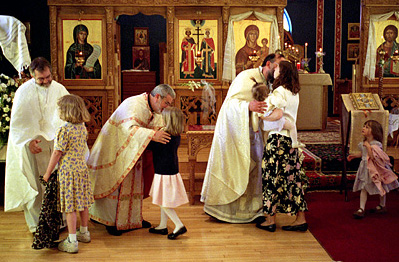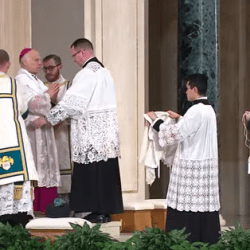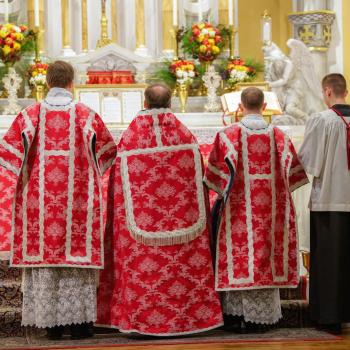If you want a deeper appreciation of what it means to exchange the “sign of peace,” take a look at this document, describing how this ancient custom will be reintroduced next month in one Eastern Rite diocese. (In the Eastern tradition, in many places clergy have been the only ones exchanging the “kiss of peace.” This explains how to instruct and include the laity in the practice.)
This offers, I think, a beautiful catechesis for all of us in the West, for whom this part of the liturgy has deteriorated too often into back-slapping, high fives and fist-bumps.
First, a little history:
It is clearly the custom referred to by Jesus when he defends the sinful woman at the house of Simon the Pharisee: “You gave me no kiss, but from the time I came in she has not stopped kissing my feet (Luke 7: 45).
The Apostle Paul instructs the Churches on three separate occasions: “Greet one another with a holy kiss” (Romans 16: 16, 1 Corinthians 16: 20, 2 Corinthians 13: 12). Similarly, Saint Paul tells the Thessalonians, “Greet all the brothers and sisters with a holy kiss” (1 Thessalonians 5: 26). The chief apostle Peter likewise closes his first epistle with the instruction, “Greet one another with a kiss of love” (1 Peter 5: 14).
Early Church
Two early reports concerning the Eucharistic celebration in the early Church confirm that the Kiss of Peace was an integral element of Christian liturgy. Justin Martyr (100-165) clearly echoes the Apostle’s instructions: “Having ended the prayers, we salute one another with a kiss.” Hippolytus of Rome (170-235) gives a more detailed treatment: “After the catechumens have finished praying, they do not give the kiss of peace, for their kiss is not yet pure. But the faithful shall greet one another with a kiss, men with men, and women with women. Men must not greet women with a kiss.”
The Kiss of Peace continued to be part of Christian worship, although its exact location in the service differed according to local custom. In the Roman Rite this exchange takes place at a later point in the Mass because of the understanding that it is a means of preparation for the reception of Holy Communion. In the Byzantine tradition the Kiss of Peace seems to have always been exchanged right before the Anaphora. Its position here is due to a very early interpretation that relates it to the preparation for bringing an offering to the altar, so that one may “first be reconciled to [one’s] brother or sister” in accordance with Mathew 5: 23-24.
Scholars who study the historical development of the Divine Liturgy make some important observations regarding the Kiss of Peace. For example, early sources show clearly that it was originally exchanged not merely among the bishops and priests as today, but among the deacons and lay people as well.
Then, how it is to be done. (Note: it takes place earlier in the Divine Liturgy, after the offertory.)
- In the Divine Liturgy, after the Great Entrance and the Litany for the Gifts, the priest faces the people and blesses, saying: Peace be with all. The choir responds: And with your spirit. The priest remains standing at the Royal Doors, facing the people.
- The deacon, standing at his usual place before the iconostasis, turns to the faithful (if no deacon, then the priest, facing the people) continues: Let us love one another so that we may be of one mind in confessing. The choir responds: The Father, the Son, and the Holy Spirit, the Trinity, one in being and undivided.
- The priest may at this point take a few moments to say a few words about the Kiss of Peace, to facilitate its introduction. The following are a few examples:
- In the Gospel of Matthew, in the Sermon on the Mount, Jesus proclaims the following. He says: “When you are offering your gift at the altar, if you remember that your brother or sister has something against you, leave your gift there before the altar and go; first be reconciled to your brother or sister, and then come and offer your gift” (Matthew 5: 23-24). Our gift of bread and wine has been presented and placed upon the altar, but before we continue with that prayer of the Church which will transform them into the Body and Blood of Christ, our Lord is asking us to be reconciled with one another. Let us reverently exchange the Kiss of Peace as a sign of our willingness to forgive one another, to be forgiven if we have offended anyone, and to be at peace.
- There are two important requirements for celebrating the Eucharist in a worthy manner pleasing to God. The first requirement is that we love one another. At the Last Supper, Jesus gave us a new commandment. He said: “This is My commandment, that you love one another as I have loved you; abide in My love.” The second requirement is that we share the same Faith. With the Kiss of Peace, we profess that we take our Lord’s commandment seriously. We strive to love one another with the love of Christ. With the Symbol of Faith, which immediately follows, we profess that we share the same Faith in the one true God, and that we seek to worship the Trinity in spirit and truth.
- Peter once came up to Jesus and said to Him, “Lord, if my brother (or sister) sins against me, how often should I forgive? As many as seven times?” Jesus said to him, “Not seven times, but, I tell you, seventy times seven” (Matthew 18: 21-22). With the Kiss of Peace, we profess our willingness and desire to forgive, no matter how many times we have been offended or hurt by our brother or sister.
- What often prevents us from living an authentic Christian life and robs us of our Christian joy is the poison of unforgiveness, resentment and bitterness. Forgiveness is not a feeling, but a conscious choice that we make. Let the Kiss of Peace today be a sign of our willful decision to forgive those who have hurt us, to let go of the debt that they may have incurred against us, and to let go of any bitter feelings of resentment, so that the Lord may restore our souls to freedom, peace and joy!
- The priest should also explain and demonstrate to the faithful how the Kiss of Peace is exchanged.
- The one who initiates the greeting says, Christ is among us; while the one who receives the greeting responds, He is and will be! At certain times of the year, this exchange is replaced by the appropriate festal greeting, for example, “Christ is Risen!”, “Indeed He is Risen!”
- The Kiss of Peace among the laity may be offered in the following ways:
- By kissing the right shoulder or cheek of the other person first, then kissing the left shoulder or cheek of the other person;
- By shaking hands; or
- By a reverent bow toward our neighbor.
- The priest’s good instruction and his personal example will be of utmost importance in upholding the rite of the “Kiss of Peace” as a sacred liturgical act of love and reconciliation and not merely a casual or even frivolous expression of salutation.
- May the restoration of the Kiss of Peace truly be a public profession of love for one another and a sign of mutual forgiveness, a means of furthering our efforts at proclaiming the Good News of the Gospel message, and a gesture of hospitality in our parishes.












